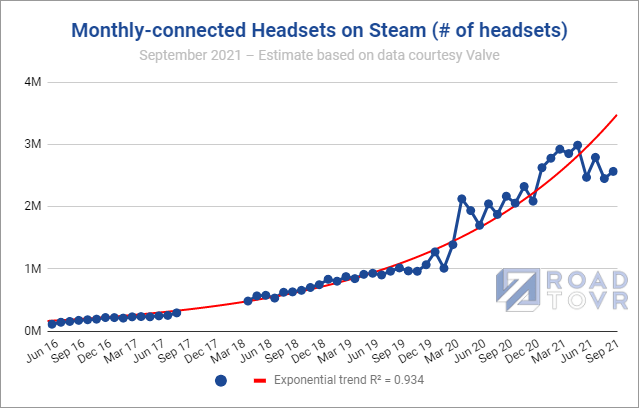While Quest 2 has certainly soaked up much of the attention as it quickly became the most used headset on Steam, Valve’s expensive Index headset has proven its longevity, now taking second place among the most used headsets on Steam.
For a headset which is now more than two years old and still priced at $1,000, it’s impressive to see Index take second place as the most used headset with 17.5% of VR users on Steam using it, according to the latest data from Valve. It got there by growing 1.51% among the share of headsets used in September, while the discontinued Oculus Rift S fell to third place with 17.21% (−0.88%) share.
Interestingly, Index previously reached its all-time high of 17.63% share back in October 2020, but that put it in third place at the time, behind Rift S at 24.64% and the original Vive at 19.17%. Index nearly took the second place spot in January 2020, but that very month Quest 2 made its debut in the data and took the second place spot for itself.
But Index has persisted, and has watched as both the original Vive and Rift S have fallen away, finally earning it the second place spot among the most used headsets on the platform. It’s not entirely surprising to see a headset outlast the Rift S (which has since been discontinued) nor the original Vive (which launched way back in 2016), but given that Index has never been discounted from its steep $1,000 price point—and that it’s more than two years old—makes it pretty impressive for it to have snatched the second place spot in 2021. Despite supply issues early on, the headset seems to have seen strong demand ever since launch, consistently ranking among the 10 highest grossing products on Steam.
Beyond Index’s new ranking, the latest data from Valve gives us an update on VR’s performance on the platform overall.
Monthly-connected VR Headsets on Steam
Each month Valve collects info from Steam users to determine some baseline statistics about what kind of hardware and software is used by the platform’s population, and to see how things are changing over time, including the use of VR headsets.
The data shared in the survey represents the number of headsets connected to Steam over a given month, so we call the resulting figure ‘monthly-connected headsets’ for clarity; it’s the closest official figure there is to ‘monthly active VR users’ on Steam, with the caveat that it only tells us how many VR headsets were connected, not how many were actually used.
While Valve’s data is a useful way see which headsets are most popular on Steam, the trend of monthly-connected headsets is obfuscated because the data is given exclusively as percentages relative to Steam’s population—which itself is an unstated and constantly fluctuating figure.
To demystify the data Road to VR maintains a model, based on the historical survey data along with official data points directly from Valve and Steam, which aims to correct for Steam’s changing population and estimate the actual count—not the percent—of headsets being used on Steam.
Overall the number of users using VR headsets on Steam grew from 1.74% to 1.8%. However, the small growth follows a trend of bouncy figures in the last few months which appear to show a slowing of VR headset adoption that started in May.
 It’s tough to say precisely what’s causing the slowdown, though a common refrain among PC VR users is that the platform hasn’t seen many major VR game releases since Half-Life: Alyx back in March of 2020. Indeed, Quest and Quest 2 have been commanding significant attention among more experienced VR developers recently.
It’s tough to say precisely what’s causing the slowdown, though a common refrain among PC VR users is that the platform hasn’t seen many major VR game releases since Half-Life: Alyx back in March of 2020. Indeed, Quest and Quest 2 have been commanding significant attention among more experienced VR developers recently.
Share of VR Headsets on Steam
While Index grew the most in the last month and took the second place spot, Quest 2 still has a major lead and, now that it’s back on sale after a month-long pause on sales, has grown to 33.19% (+1.04%) of all VR headsets in use on Steam.
 Rift S, the original Quest, Windows Mixed Reality, and the original Vive lost the most share over the last month, with Rift S at 17.21% (–0.88%), Quest at 5.02% (–0.68%) Vive at 9.70% (–0.31%), and Windows Mixed Reality at 5.48% (–0.31%).
Rift S, the original Quest, Windows Mixed Reality, and the original Vive lost the most share over the last month, with Rift S at 17.21% (–0.88%), Quest at 5.02% (–0.68%) Vive at 9.70% (–0.31%), and Windows Mixed Reality at 5.48% (–0.31%).
As for the share among headset vendors, although Quest 2 grew in the last month, Oculus overall dropped to 60.71% (–0.42%) due to losses from Rift S and the original Quest. Despite being the most recent vendor to release a new PC VR headset (Vive Pro 2), HTC’s share continues its long decline, now down to 13.89% (–0.56%).
 The only major vendor that grew its share in the last month is actually Valve which, despite offering only a single headset, is the third largest vendor of VR headsets used on Steam.
The only major vendor that grew its share in the last month is actually Valve which, despite offering only a single headset, is the third largest vendor of VR headsets used on Steam.







